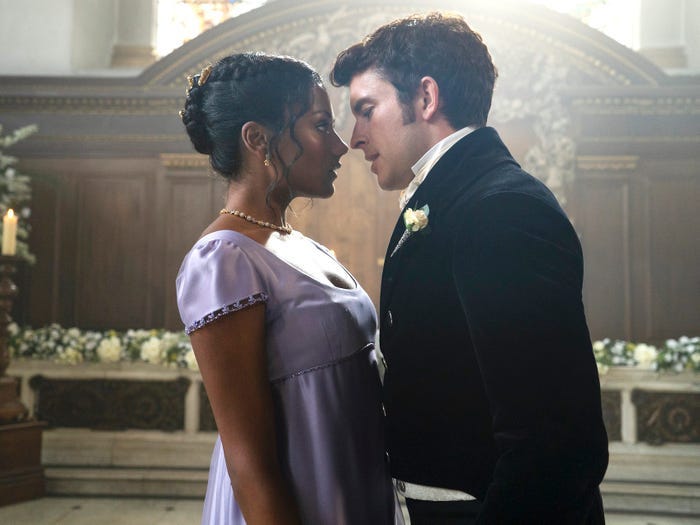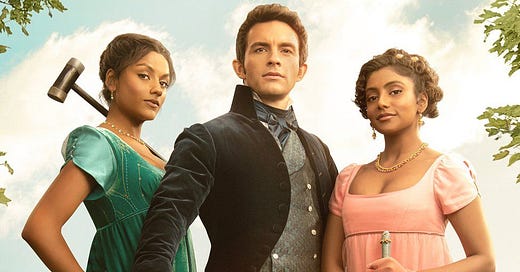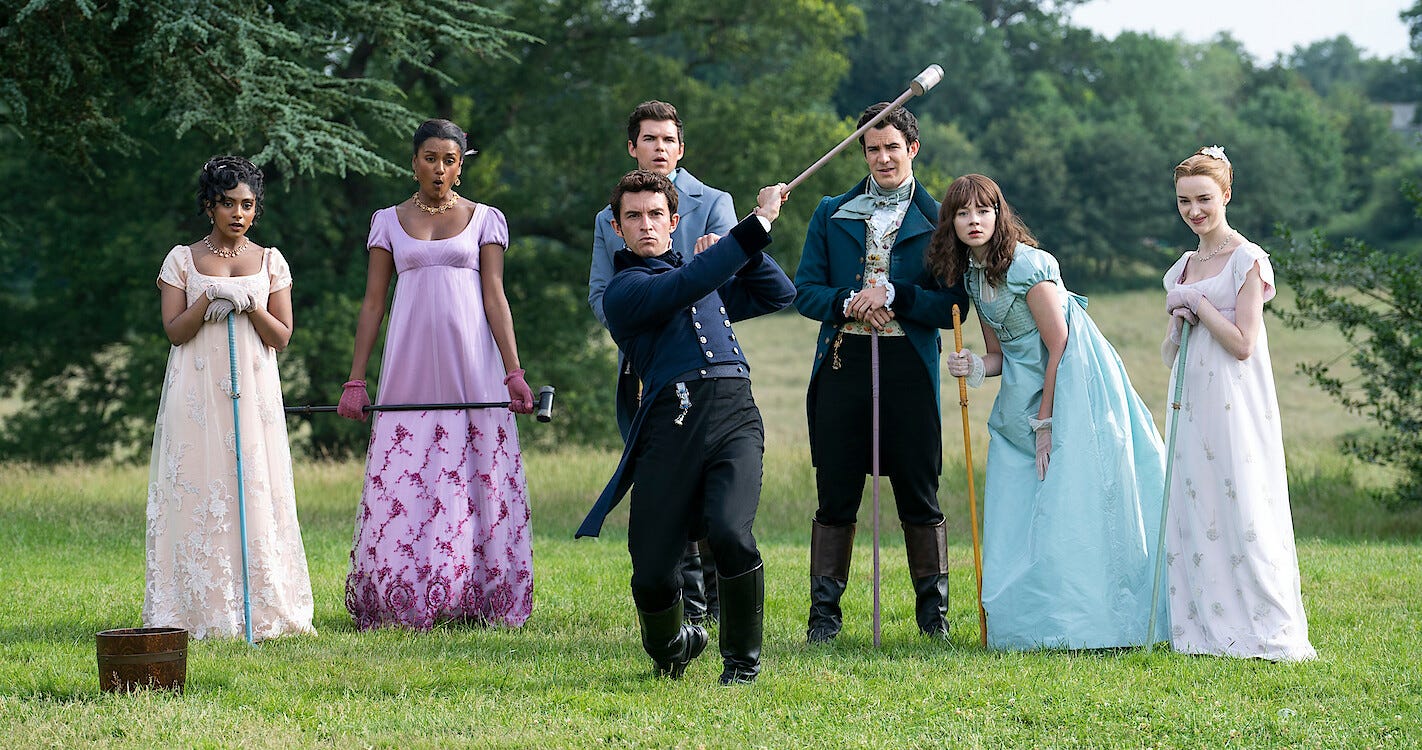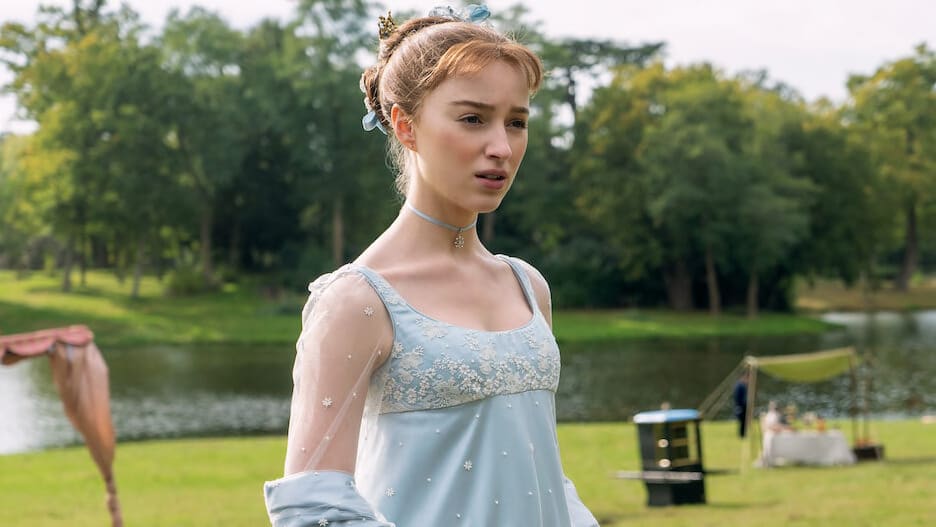All About Love
There is much to analyze and problematize in shows like the popular “Bridgerton" and the romance genre writ large. On the other hand, it’s just what the doctor ordered.
[Spoilers ahead for both seasons of “Bridgerton” and the first three installments of the book series.]
Lately, the only genre of media I can handle is romance.
It started in late March when I got a concussion from hitting my head on the corner of a cabinet at my brother’s house, which somehow resulted in over a month of debilitating migraines. I had to limit mental exertion and screen time, so I quickly found a touch of respite in the romance genre. Since the concussion, I’ve read maybe 10 romance novels, though I’ve been embarrassed to add all of them to my Goodreads account. These have included the YA bestsellers Red, White, and Royal Blue and One Last Stop by Casey McQuiston, People We Meet on Vacation by Emily Henry, The Seven Husbands of Evelyn Hugo by Taylor Jenkins Reid, and a few others that stretch the limits of the genre, like Olga Dies Dreaming by Xóchitl González and a reread of Conversations with Friends ahead of the release of the TV adaptation.
My foray into romance wasn’t just limited to books, though– I also gave in to the guilty pleasure phenomenon that is both seasons of “Love is Blind,” an utterly ridiculous and absurdly addictive reality show where people fall in love and get engaged through a wall and then have to get married within a month, and the accompanying “The Ultimatum,” an honestly gross, but similarly addictive emotional manipulation. Then, of course, there was season 2 of “Bridgerton,” which, reader, I loved.
Though romance gets a bad rap, especially from snooty former English majors like myself, I credit it for helping me barely hold on emotionally during a really difficult time. In its broadest definition, romance has two essential qualities: first, it must center around a couple of some sort. Two, it must have a happy ending. This second element has been most important to my emotional wellbeing in the last couple months. There’s something so comforting about knowing that the only stakes are two people, ultimately, and that everything will be alright in the end. It’s almost the opposite of the dumpster fire that is the world right now, with the probable undoing of Roe, the ever-present myth that Covid is over, the Ukraine crisis, climate armageddon, and other tragedies I can’t think about without the threat of a headache rebound.
I know there are bigger things happening in the world, and more serious topics to pursue, and the political junkie side of me feels guilty for not following them more closely in the last few months. Though the migraine dissipated after a hellish six weeks, I feel more reliant on the fantasy of the romance genre more than ever–I’m back in California, helping my mom after she broke her hip, mostly with taking over a lot of the ins-and-outs of managing my brother’s care. (Thank god for Paid Family Medical Leave, because this job is way more stressful and emotionally taxing than my regular one… though I do get to sleep in!) But every morning I eat breakfast and read the Bridgerton books, and things feel a little bit more okay.
In the first weeks of my migraine, I limited myself to one hour of television per day, as looking at a screen exacerbated its effects. This fortunately coincided with the release of season 2 of “Bridgerton.” To be honest, I had some Issues with the first season of the show. First of all, I found its protagonist, Daphne, to be exceedingly dull, and later, extremely problematic. In one of her recent shows, the comedian Michelle Buteau had a hilarious bit about Daphne– in a show known for characters with outlandish costumes and ornate hairstyles, Daphne’s bangs are unforgivably lame; they look like “two quotation marks” on her forehead. The first season of the show was also notorious for its supposedly steamy sex scenes, which I thought were completely overblown, and I’m a person who does things like turn the television volume down to 4 if I’m watching something with a sex scene, even if I’m alone. Like, we’ve all seen HBO. Calm down. I take “Bridgerton” and wager you “Outlander.”
“Bridgerton,” which is executive produced by Shonda Rhimes, follows two recent trends in media for period pieces– like “Hamilton,” it’s a historical drama that features actors of color in roles that would typically go to British white men. It also doesn’t make any great effort to be historically accurate – like 2018’s “The Favourite” and the 2020 series “The Great” by Tony McNamara – and before it, Sofia Coppola’s 2006’s “Marie Antoinette”. In these works, the historical inaccuracies are obvious and seemingly intentional, and mined as a source of humor and insight. Pop songs are played by string quartets while actors of all races dance to traditional waltzes.
In some ways, I love the idea of casting actors of color in these kinds of roles, and putting more people of color behind the camera. Now, romantic heroines are not only Elizabeth Bennetts but also Kate Sharmas, in a genre that has historically been completely inaccessible to actors of color. This is undoubtedly a Good Thing. Bringing multiracial actors, writers, producers, and directors into more Hollywood productions brings new perspectives, shining new light on stories that have in some cases been told already, in the same way, countless times (see: any Jane Austen adaptation). It is undoubtedly meaningful for young POC people to see themselves reflected in the media they are consuming.
Yet this representation seems to stop short of providing much commentary on racism itself, thus falling prey to colorblindness. In “Bridgerton,” this issue is clumsily explained away: when Queen Charlotte, who in reality may have been part African and in the show is played by Black actress Golda Roshuevel, married the white King George, racism… ended. The whole of British court society saw love conquer all and wiped their hands of the whole pesky colonialism thing! Wasn’t that easy? Okay, writers. Real “racism ended when Barack Obama was elected” energy there. Or maybe more Meghan and Harry energy. You can tell by the way this detail is shoehorned into a late episode in the first season and never mentioned ever again that everyone involved thought it was pretty dumb.
While the first season of “Bridgerton” featured a Black romantic hero played by Regé Jean-Page, who awkwardly does not appear in the second season, the second one centers around a different Bridgerton sibling – there are eight – Anthony (Jonathan Bailey), the eldest, and love interests Edwina (Charithra Chandran) and Kate Sharma (Simone Ashley), who have come from India for the London “season,” with the help of wealthy noble benefactor, Lady Danbury. Interestingly, in the books the sisters are Edwina and Kate Sheffield, who are white and British. (Also interestingly, in the books the romantic heroines of each are meant to be rather ordinary looking, and in the show they are um, not. On the Slate culture podcast, The Waves, Rachelle Hampton argues that making Daphne pretty ruined the whole point of the first season). While the show also adds in some commentary about class – Edwina and Kate are half-sisters, and their mother, Mary, married their lower-class father even though he had another child, Kate, much to the chagrin of Mary’s parents, who disowned their daughter. But the class commentary stops there – entrance into the British court, it seems, is really the only status that matters in the world of “Bridgerton.” That and who you marry. The show does have something to say about this in the form of younger sister Eloise Bridgerton, who some have critiqued basically functions as a feminist bot, but ultimately, as is inherent to its genre, marriage and babies are the ultimate goal to which all will, eventually, fall prey.
But the show fails to go any deeper into the kinds of discrimination the family may have faced for their skin color in court, or any history or context of British colonization in India. Considering the depth of that history, it’s a rather gaping hole. Even if the show isn’t going for historical accuracy, it’s missing a huge opportunity. It also fumbles in its portrayal of Indianness, sometimes dealing in stereotypes rather than specifics about, for example, which part of India the Sharmas are supposedly from.
As Gary Younge wrote for The Nation (yes, The Nation did a cover story on “Bridgerton”), “The creation of a diverse world in which race is not an issue is both one of executive producer Shonda Rhimes’s commercial superpowers and narrative kryptonite. There is a lucrative market, particularly on-screen, for the depiction of racial difference in the absence of racial inequality.” However, he continues, “There is an important debate to be had that goes beyond popular television to the kind of diversity we’d like to have: one where the world looks different—or one where the society actually operates differently.”
There’s an additional layer to this problem, which is, even if a production like “Bridgerton” is entirely driven by a Black creator, writers, and actors, it’s still an adaptation of a book series written by a white author about white people. Rather than new takes on old stories, why not support the development of new stories by creators of color entirely, fostering new perspectives that don’t cater to white audiences, like those found in shows like “Insecure” and “I May Destroy You”? Of course, this isn’t, and shouldn’t be, mutually exclusive.
Despite all these issues, I found the second season of “Bridgerton” to be an utter delight. This is mostly due to the charisma and chemistry of the two romantic leads, Anthony Bridgerton (Jonathan Bailey) and Kate Sharma (Simone Ashley), in one of my favorite (I think) romance tropes: enemies-to-lovers. There is truly nothing more fun to watch than verbal sparring between two excessively attractive people who are obsessed with each other (Seth and Summer in “The O.C.” come to mind). Obviously, it’s entirely predictable from the moment we see Simone Ashley’s face, revealed after they inadvertently race their horses (she wins), that the two are meant for each other. Oho, this former rake has met his match!

But as I learned from Rachelle Hampton’s podcast, the romance genre is aware that it’s predictable. We all know how it ends. That isn’t the point. And there’s a range of different tropes it uses, from enemies to lovers to fake-dating-turns-into-real-dating (as seen in the first season of “Bridgerton.”) We’re well past the peak rom-com era that characterized the late ‘90s and most of my childhood. But perhaps we’re seeing a resurgence of sorts with shows like “Bridgerton” and “Jane the Virgin.” While I sometimes find myself rolling my eyes, there’s something so comforting about things turning out (a) how you think they will, and (b) nicely. You simply have to suspend disbelief in order to enjoy it.
And that’s why, in a tough time, I’m relying on the frivolous fantasy of the Bridgerton book series to get me through. Forgot cognitive behavioral therapy when you have British regency escapism.
What I’m Watching: Besides “Bridgerton” and the “Love is Blind” franchise, I just finished watching “The Dropout” with my brother, and it was great. In the end, it’s really an ode to the power of journalism and government regulation, my two favorite things!





